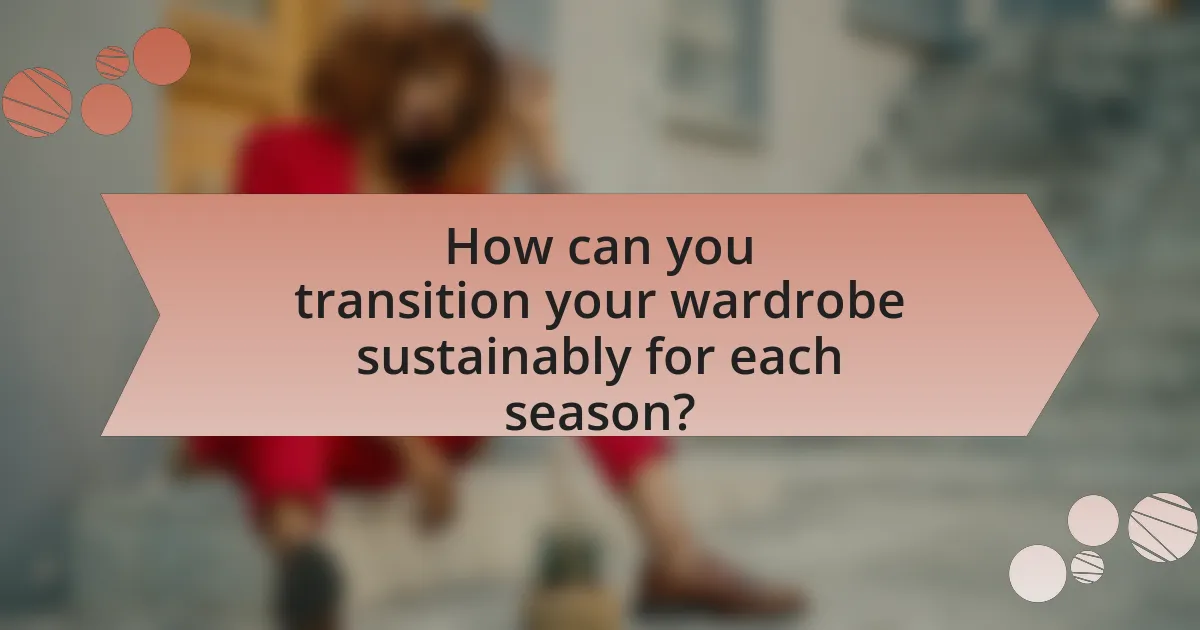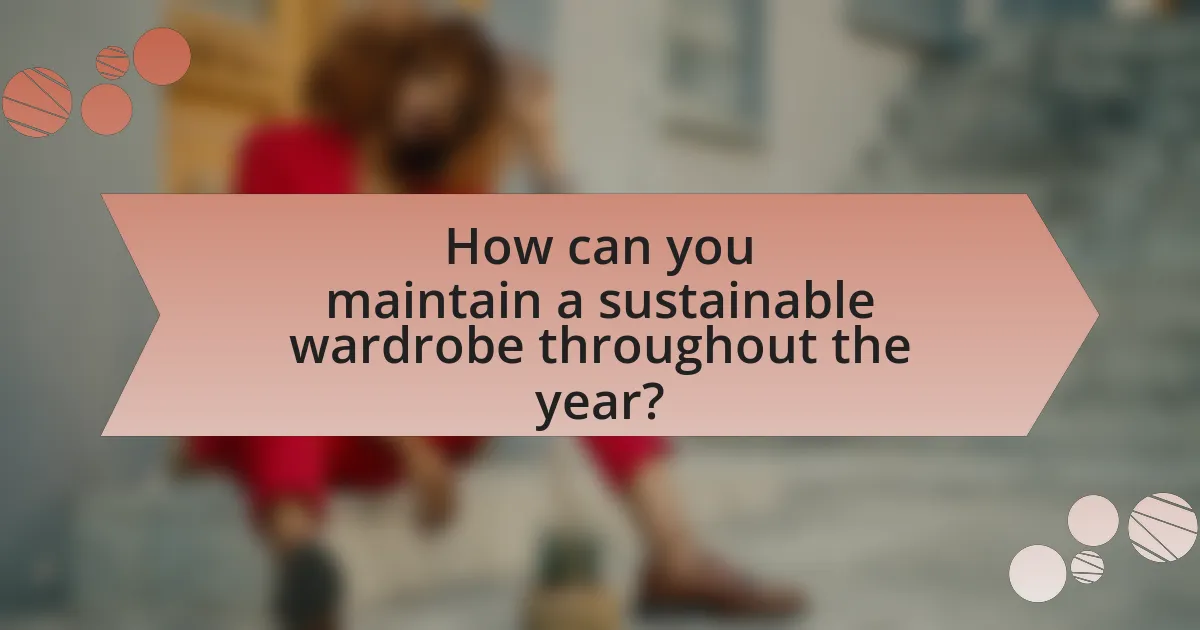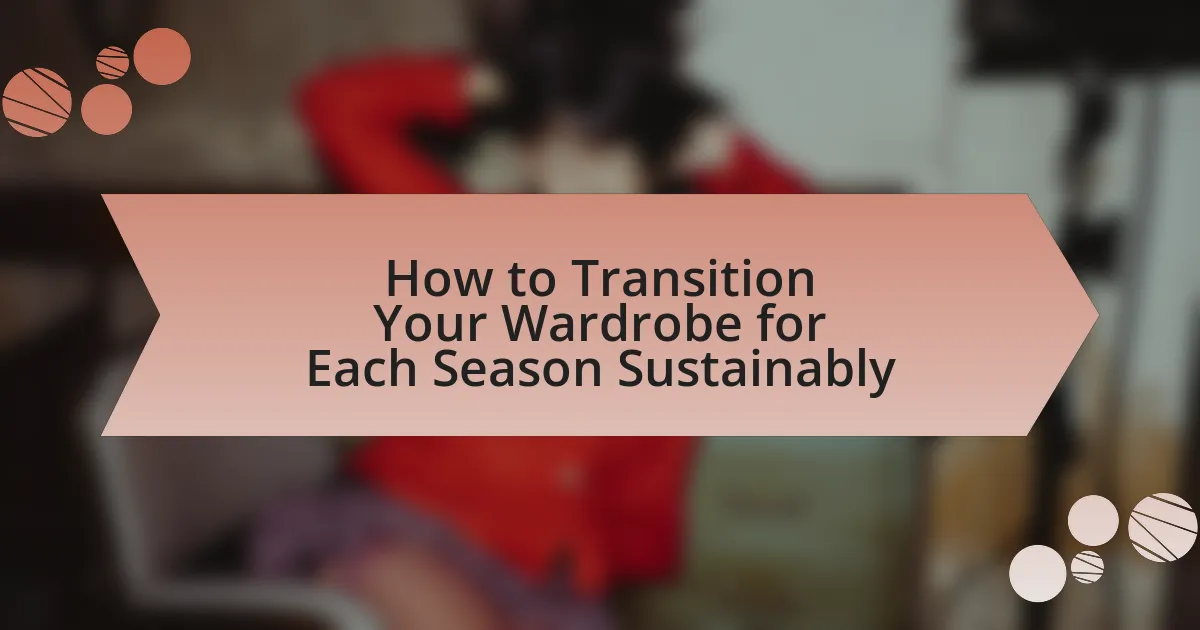The article focuses on transitioning your wardrobe sustainably for each season, emphasizing the importance of mindful consumption, quality over quantity, and circularity in fashion. It outlines practical steps for assessing current clothing, incorporating versatile pieces, and utilizing sustainable materials to minimize environmental impact. Key strategies include engaging in clothing swaps, donating or recycling unwanted items, and adopting a capsule wardrobe approach to enhance sustainability. Additionally, the article discusses the environmental consequences of fast fashion and highlights the benefits of maintaining a sustainable wardrobe throughout the year.

How can you transition your wardrobe sustainably for each season?
To transition your wardrobe sustainably for each season, start by assessing your current clothing and identifying items that can be reused or repurposed. This practice reduces waste and promotes a circular economy. For instance, consider layering summer clothes with winter pieces or using accessories to adapt outfits for different seasons.
Next, prioritize purchasing high-quality, versatile clothing made from sustainable materials, such as organic cotton or recycled fabrics, which have a lower environmental impact. According to the Global Fashion Agenda, sustainable fashion can reduce greenhouse gas emissions by up to 30% if consumers choose eco-friendly options.
Additionally, engage in clothing swaps with friends or local community groups to refresh your wardrobe without buying new items. This not only extends the life of garments but also fosters community connections.
Finally, donate or sell items you no longer wear, ensuring they are given a second life rather than ending up in landfills. The Environmental Protection Agency states that textile recycling can divert millions of tons of waste from landfills each year.
What are the key principles of sustainable wardrobe transition?
The key principles of sustainable wardrobe transition include mindful consumption, quality over quantity, and circularity. Mindful consumption emphasizes purchasing only what is necessary and choosing items that align with personal values and environmental impact. Quality over quantity focuses on selecting durable, timeless pieces that reduce the need for frequent replacements, thereby minimizing waste. Circularity involves considering the entire lifecycle of clothing, including options for recycling, upcycling, or donating items when they are no longer needed, which helps to extend the life of garments and reduce landfill contributions. These principles collectively promote a more sustainable approach to fashion and wardrobe management.
Why is sustainability important in fashion?
Sustainability is important in fashion because it addresses environmental degradation and promotes ethical practices within the industry. The fashion industry is responsible for significant pollution, with textile production contributing to 20% of global wastewater and 10% of carbon emissions, according to the United Nations Environment Programme. By prioritizing sustainable practices, such as using eco-friendly materials and reducing waste, the industry can mitigate its negative impact on the planet and promote social responsibility.
What are the environmental impacts of fast fashion?
Fast fashion significantly harms the environment through excessive resource consumption, pollution, and waste generation. The industry is responsible for approximately 10% of global carbon emissions, primarily due to the energy-intensive processes involved in manufacturing and transporting clothing. Additionally, fast fashion contributes to water pollution, as the dyeing and finishing processes release toxic chemicals into waterways, affecting aquatic ecosystems. Furthermore, the production of fast fashion items often leads to massive textile waste; around 92 million tons of textiles are discarded annually, with a large portion ending up in landfills. These factors collectively illustrate the detrimental environmental impacts of fast fashion.
How do seasonal changes affect wardrobe needs?
Seasonal changes significantly affect wardrobe needs by necessitating the inclusion of different clothing types suitable for varying weather conditions. For example, colder months require warmer garments such as coats, sweaters, and thermal layers, while warmer months call for lighter fabrics like cotton and linen, as well as short-sleeved shirts and shorts. This shift is supported by the fact that temperature variations can range from below freezing in winter to over 90 degrees Fahrenheit in summer, influencing fabric choice and layering strategies. Additionally, seasonal trends often dictate the styles and colors that are popular, further impacting what individuals choose to wear during different times of the year.
What types of clothing are essential for each season?
Essential clothing for each season includes specific items tailored to weather conditions. In spring, lightweight jackets, long-sleeve shirts, and breathable fabrics are crucial for fluctuating temperatures. Summer necessitates shorts, tank tops, and swimwear to accommodate heat. Autumn requires layering pieces such as sweaters, cardigans, and scarves to manage cooler days. Winter demands insulated coats, thermal wear, and boots to protect against cold and snow. These clothing types are essential as they provide comfort and protection suited to seasonal changes.
How can you assess your current wardrobe for seasonal suitability?
To assess your current wardrobe for seasonal suitability, begin by categorizing your clothing into seasonal groups: spring, summer, fall, and winter. This method allows you to visually identify which items are appropriate for the current season. Next, evaluate each item based on its fabric, color, and style; for instance, lightweight fabrics like cotton and linen are suitable for warmer months, while heavier materials like wool and fleece are ideal for colder seasons. Additionally, consider the frequency of wear for each item during the season; items that have not been worn in the past year may not be suitable for your current wardrobe needs. This systematic approach ensures that your wardrobe aligns with seasonal requirements, promoting both functionality and sustainability.
What strategies can you use for a sustainable wardrobe transition?
To achieve a sustainable wardrobe transition, prioritize quality over quantity by investing in durable, ethically produced clothing. This strategy reduces waste and encourages responsible consumption. For instance, according to a 2021 report by the Ellen MacArthur Foundation, extending the life of garments by just nine months can reduce carbon, water, and waste footprints by 20-30%. Additionally, consider implementing a capsule wardrobe approach, which focuses on a limited selection of versatile pieces that can be mixed and matched, further promoting sustainability.
How can you effectively declutter your wardrobe?
To effectively declutter your wardrobe, start by removing all items and categorizing them into keep, donate, and discard piles. This method allows for a clear assessment of what you truly wear and need. Research indicates that people wear only 20% of their wardrobe regularly, suggesting that a significant portion can be eliminated without loss (source: “The Psychology of Clutter,” Journal of Environmental Psychology, 2018). After sorting, ensure that the items you keep are versatile and fit well, which promotes a sustainable wardrobe transition for each season.
What are the best practices for recycling or donating clothes?
The best practices for recycling or donating clothes include ensuring items are clean and in good condition, researching local charities or organizations that accept clothing donations, and utilizing textile recycling programs when items are too worn to donate. Clean and wearable clothing can be donated to shelters, thrift stores, or community organizations, which often rely on such donations to support their missions. According to the Environmental Protection Agency, in 2018, 11.3 million tons of textile waste were generated in the U.S., highlighting the importance of recycling and donating to reduce landfill contributions. Additionally, many municipalities offer textile recycling services that can repurpose worn-out clothing into new materials, further promoting sustainability.

What are the steps to prepare your wardrobe for a new season?
To prepare your wardrobe for a new season, follow these steps: first, assess your current clothing by removing all items from your closet and evaluating each piece for wear, fit, and style relevance. This process allows you to identify what to keep, donate, or discard. Next, clean your wardrobe space thoroughly to create an organized environment. Afterward, categorize your clothing into seasonal groups, ensuring that items appropriate for the upcoming season are easily accessible. Finally, incorporate versatile pieces that can be layered or mixed and matched, enhancing sustainability by maximizing outfit options. This method not only streamlines your wardrobe but also promotes mindful consumption by encouraging the use of existing clothing.
How can you create a seasonal wardrobe plan?
To create a seasonal wardrobe plan, first assess your current clothing inventory and categorize items by season. This involves identifying which pieces are suitable for spring, summer, fall, and winter based on fabric, color, and style. Next, determine your lifestyle needs and preferences for each season, which can include factors like climate, activities, and occasions.
Once you have a clear understanding of your wardrobe and seasonal requirements, curate a list of essential items for each season, ensuring versatility and functionality. For example, include layering pieces for transitional weather and select a color palette that complements your existing items.
Finally, implement a rotation system where you store off-season clothing and keep current seasonal items accessible, allowing for easy transitions. This method not only optimizes space but also encourages mindful consumption by focusing on quality over quantity.
What factors should you consider when planning your seasonal wardrobe?
When planning your seasonal wardrobe, consider climate, personal style, and versatility. Climate dictates the types of fabrics and layers needed; for example, heavier materials are essential for winter, while lighter fabrics are suitable for summer. Personal style influences the selection of colors and silhouettes that reflect individual preferences. Versatility is crucial, as choosing pieces that can be mixed and matched across seasons maximizes utility and minimizes waste. According to a study by the Ellen MacArthur Foundation, extending the life of clothing by just nine months can reduce carbon, water, and waste footprints by 20-30%.
How can you incorporate versatile pieces into your wardrobe?
Incorporating versatile pieces into your wardrobe involves selecting items that can be styled in multiple ways for different occasions. For example, a classic white button-up shirt can be paired with jeans for a casual look or with a blazer for a more formal setting. Research indicates that a capsule wardrobe, which emphasizes versatile pieces, can reduce decision fatigue and promote sustainable fashion choices by encouraging the use of fewer, high-quality items. This approach not only enhances personal style but also contributes to a more sustainable wardrobe transition across seasons.
What role does fabric choice play in seasonal transitions?
Fabric choice significantly influences comfort and functionality during seasonal transitions. Different fabrics provide varying levels of insulation, breathability, and moisture-wicking properties, which are essential for adapting to changing temperatures. For instance, lightweight cotton and linen are ideal for warmer months due to their breathability, while wool and heavier blends offer warmth in colder seasons. Studies show that natural fibers like cotton and wool regulate body temperature effectively, enhancing comfort across different climates. Thus, selecting appropriate fabrics is crucial for maintaining comfort and style throughout the year.
Which sustainable fabrics are best for different seasons?
Linen and organic cotton are the best sustainable fabrics for summer due to their breathability and moisture-wicking properties, which keep the body cool in hot weather. For fall, Tencel and wool are ideal as they provide warmth while being biodegradable and sourced from sustainable practices. In winter, organic wool and recycled polyester are effective, as they offer insulation and durability, with recycled polyester reducing waste. Lastly, for spring, hemp and bamboo are excellent choices, as they are lightweight and promote moisture absorption, making them suitable for the transitional weather. These fabrics not only support sustainability but also cater to the specific needs of each season.
How can you care for your clothes to extend their lifespan?
To extend the lifespan of your clothes, wash them in cold water and air dry whenever possible. Washing in cold water reduces energy consumption and minimizes fabric wear, while air drying prevents shrinkage and damage from high heat. Additionally, using a gentle detergent and avoiding bleach can help maintain fabric integrity. According to the Environmental Protection Agency, washing clothes in cold water can save up to 90% of the energy used for heating water, making it both an eco-friendly and fabric-friendly choice. Regularly rotating your wardrobe and storing clothes properly, such as using breathable garment bags, also contributes to their longevity by preventing damage from pests and environmental factors.

How can you maintain a sustainable wardrobe throughout the year?
To maintain a sustainable wardrobe throughout the year, prioritize quality over quantity by investing in durable, ethically-made clothing. This approach reduces waste and encourages responsible consumption, as high-quality garments typically last longer and require fewer replacements. Additionally, practice seasonal decluttering by regularly assessing your wardrobe to donate or recycle items you no longer wear, which helps minimize landfill contributions. According to the Ellen MacArthur Foundation, the fashion industry is responsible for 92 million tons of waste annually, highlighting the importance of sustainable practices. Lastly, consider adopting a capsule wardrobe, which consists of versatile pieces that can be mixed and matched, further promoting sustainability by reducing the need for excessive clothing purchases.
What are the benefits of a capsule wardrobe?
A capsule wardrobe offers several benefits, including simplicity, versatility, and sustainability. By limiting the number of clothing items to essential pieces, individuals can streamline their wardrobe, making it easier to choose outfits and reducing decision fatigue. This approach promotes versatility, as each item is selected to mix and match with others, maximizing outfit combinations. Additionally, a capsule wardrobe supports sustainability by encouraging mindful consumption, reducing the frequency of purchases, and minimizing textile waste. Studies indicate that consumers who adopt a minimalist wardrobe tend to buy fewer clothes, which can lead to a significant reduction in environmental impact.
How can a capsule wardrobe simplify seasonal transitions?
A capsule wardrobe simplifies seasonal transitions by providing a curated selection of versatile clothing items that can be easily mixed and matched. This approach reduces the need for extensive shopping each season, as the limited number of pieces allows for quick outfit changes that are appropriate for varying weather conditions. Studies show that a capsule wardrobe can lead to a more sustainable fashion practice, as it encourages mindful consumption and reduces textile waste. By focusing on quality over quantity, individuals can adapt their wardrobe to seasonal changes without the stress of overhauling their entire closet.
What are the key components of a successful capsule wardrobe?
A successful capsule wardrobe consists of versatile, high-quality pieces that can be mixed and matched to create various outfits. Key components include a limited number of essential clothing items, such as tops, bottoms, outerwear, and shoes, typically totaling around 30 to 40 pieces. These items should be chosen based on personal style, fit, and functionality, ensuring they can be worn across different occasions and seasons. Additionally, a successful capsule wardrobe emphasizes neutral colors and classic styles, which enhance the ability to combine items seamlessly. This approach not only simplifies daily outfit choices but also promotes sustainability by reducing overconsumption and encouraging mindful purchasing.
How can you stay informed about sustainable fashion trends?
To stay informed about sustainable fashion trends, regularly follow reputable fashion publications, blogs, and social media accounts dedicated to sustainability. Sources like Vogue’s sustainability section, Eco-Age, and the Good Trade provide up-to-date information and insights on eco-friendly practices and brands. Additionally, subscribing to newsletters from organizations such as the Sustainable Apparel Coalition can keep you informed about industry standards and innovations. Engaging with online communities and forums focused on sustainable fashion also offers real-time discussions and shared resources, enhancing your knowledge and awareness of current trends.
What resources are available for learning about sustainable fashion?
Resources for learning about sustainable fashion include online courses, books, documentaries, and websites dedicated to the topic. Online platforms like Coursera and edX offer courses on sustainable fashion practices, while books such as “Fashionopolis” by Dana Thomas provide in-depth insights into the industry. Documentaries like “The True Cost” highlight the environmental and social impacts of fashion, and websites such as the Sustainable Fashion Forum and Fashion Revolution provide articles, guides, and community support for those interested in sustainable practices. These resources collectively offer a comprehensive understanding of sustainable fashion principles and practices.
How can you connect with communities focused on sustainable fashion?
To connect with communities focused on sustainable fashion, engage with online platforms such as social media groups, forums, and dedicated websites that promote sustainable practices. For instance, platforms like Instagram and Facebook host numerous groups where individuals share tips, resources, and experiences related to sustainable fashion. Additionally, attending local events, workshops, or meetups organized by sustainable fashion advocates can foster direct connections. Research indicates that community engagement significantly enhances awareness and participation in sustainable practices, as seen in initiatives like Fashion Revolution, which mobilizes individuals globally to advocate for ethical fashion choices.
What practical tips can help you transition your wardrobe sustainably?
To transition your wardrobe sustainably, start by assessing your current clothing items and identifying those that you no longer wear or need. This practice not only declutters your space but also allows you to donate or recycle garments, reducing waste. Next, invest in high-quality, versatile pieces made from sustainable materials, as they tend to last longer and have a lower environmental impact. Additionally, consider adopting a capsule wardrobe approach, which encourages mindful purchasing and helps you maximize outfit combinations with fewer items. Research indicates that the fashion industry is responsible for 10% of global carbon emissions, highlighting the importance of sustainable practices in wardrobe management. By following these tips, you can effectively transition your wardrobe while contributing to environmental conservation.
